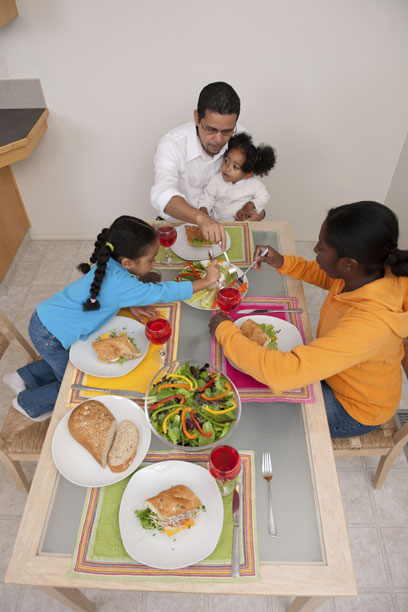 Perhaps this routine sounds familiar:
Perhaps this routine sounds familiar:
As a nurse practitioner, Sammamish mom Gail Brown may work until 7 p.m. Dad works and frequently travels. Their 17-year-old-daughter, Lindsay, a competitive dancer, has classes that start after school and last as late as 9 p.m. several times a week. Fourteen-year-old Joey plays basketball on travel teams, which means evening practices for at least two hours, smack during dinner time.
Refueling may happen on the go, even at the dance studio. The family struggles to find time to sit down for a meal with everyone at the table, and when they do, it’s sure not likely to be in a formal dining room.
Alec Puskas, an interior designer with Visionart in Seattle, says he recently butted heads with a realtor over the notion of family mealtime. In staging a new home for an area homebuilder, he favored setting up a traditional family dining area. But the realtor listing the home disagreed.
“She said the majority of people who come in don’t want formal dining. They’ll eat in the kitchen or at an informal table, but it’s more about an area where kids can do homework or have a computer nearby,” Puskas says.
The meal table, traditionally the American family’s touchstone, is becoming just another horizontal surface; a laptop stand, homework center or even the home office. Our dinner “hour” is squeezed or replaced by work commitments and a plethora of kids’ activities encroaching on family schedules like never before.
But what are we really losing when we ditch the formal dinnertime along with the formal dining table? Are we losing invaluable opportunities to connect with our kids on many levels — socially, emotionally, spiritually and, of course, nutritionally? Should we be concerned about this societal shift and if so, what should we do about it? And just how did we get here in the first place?
Too much on our plates?
“When I was growing up, sports were not so competitive,” says Brown. “But now, if kids aren’t playing year-round, getting trained up in middle school, there’s no way they will play for a 4A high school; in fact, some of these kids even add in personal trainers.”
With so many moving parts, it’s a well-oiled machine parents are operating. But the machine needs downtime, and experts say it is in maintenance that we are falling short.
“I think if you ask any parent, they would say, ‘Yes, sitting down and enjoying family dinner together is a priority,’” says Judy Burr-Chellin the director of Parent/Child Services for Wellspring Family Services. “But people’s schedules get impossible, not just parents’ work, but kids’ activities. Most parents are trying to do the best they can with children’s best interests at heart.”
Having been a child therapist for 30 years, Burr-Chellin believes there is increased strain on middle and higher socio-economic levels, as well. “The more affluent families are often engaging their kids in more activities because they can.”
But for all the benefits of top-notch extracurriculars, perhaps we also need to ask what are the costs? What exactly are we missing when, as a 2003 Gallup poll reports, we sit down to dinner as a family for fewer than half of those meals?
“Engagement,” says Kathleen Ferrigno of the National Center on Addiction and Substance Abuse (CASA) at Columbia University. “The connection and conversation that happens with family dinner, it sends a message that parents care, that parents are willing to make moments in hectic lives.”
Meals together matter
According to a 2010 CASA study, there is a correlation between family dinners and a tendency toward teen drug use. Specifically, CASA found that teens who have three or fewer family dinners a week are twice as likely to say they expect to try drugs in the future as those teens who have family dinner five times or more each week. Teens who have frequent family dinners are also less likely to report having friends who use substances like drugs and alcohol. “It 100 percent comes back to how young people feel about themselves, their self-esteem and potential to do bigger and better things,” says Ferrigno.
Simmone Misra works full-time at Microsoft and is raising a 12-year-old son with her husband, who also works. Mealtime is a top priority, their highest priority, in fact, behind work, which she describes as “nonnegotiable.”
“There are theories about work-life balance, but they don’t work in the micro sense,” explains Misra. “If I have a call with Japan, I have to do it. But where I can control, in the macro sense, is our other family priorities.” She loves cooking traditional Indian meals and cherishes that shared meal as unique time together.
Having grown up in Bombay (now Mumbai), Misra sees cultural differences with modern American culture. “Where I grew up, there was no such thing as sports in the evenings or weekends; it just doesn’t happen.” But food and meals are paramount. “That is a multigenerational experience you cannot get any other time, where a child can be taught things without knowing that they are learning,” says Misra.
There can be a very positive synergy that happens when family members gather around a table together. Think of those wooden “charging centers” sold by Pottery Barn and others where all family members can deposit their various electronic devices in one space for powering their batteries. Could it be we need to rethink our family meal table as a sort of recharging center for our spiritual batteries?
 What’s nutrition got to do with it?
What’s nutrition got to do with it?
If it is kids’ sports crowding out a family’s sit-down mealtime, there is particular irony in that children are unhealthier for it.
Weight Watchers’ book Family Power: 5 Simple Rules for a Healthy-Weight Home reports a nearly 300 percent increase in the amount of food that children ate away from home between 1977 and 1996, and the resulting effect of less-balanced diets. Children eating at home tend to eat more fruits, vegetables and high-fiber foods and less fried foods, and drink fewer soft drinks. No surprise there. Anyone who cooks regularly knows that cleaning up grease splatters is a hassle.
Children who eat at home “learn from these meals how to enjoy a variety of foods and how to try new foods, and they become familiar with healthy-weight eating skills,” writes Karen Miller-Kovach, one of the co-authors of Family Power.
“From an early age, a family should ask itself what it wants its food culture to look like,” says Michelle Babb, a Seattle nutritionist who teaches cooking classes at local PCC markets. She particularly enjoys getting picky eaters excited about healthy ingredients.
“I once worked with a 3-year-old who wouldn’t eat any veggies, so I had a cooking workshop where he got to tear up lettuce. He started eating it, and I remember his mom saying to me, ‘What’s he doing?’” If a child is invested in the meal, no matter what the job, he is more likely to eat the fruits of his labor.
Let’s be honest, it won’t always work. (No matter how much my mom tried to change my mind, I hated cauliflower as a kid and still do.) But luckily, most of the time, children acquire a taste for food if exposed to it repeatedly. “I like the idea of not warring or engaging in power struggles,” says Babb. “Instead, acknowledge that kids go through picky stages. At every meal, have one thing on the table you know everyone will eat, whether a side dish, a vegetable, and do experiment with different foods.”
Setting the table for the future
From a nutrition standpoint, children do not need to get a well-balanced meal at every single meal. But do keep trying those new “hated” foods. “Try again when the child is a few months older,” recommends Weight Watchers. “The most important factor [in eating a variety of foods as an older child] was a child’s exposure to foods before the age of four.” Parents should have a backup plan if the child walks away without eating dinner. They should agree whether a late snack will be allowed or whether a piece of fruit may be an alternative. “The worst thing is for parents to undermine each other,” says Babb.
Family meals can also set the stage for a lifelong appreciation of good food. Ailish O’Sullivan, a 20-year-old senior at the University of Washington, rowed crew for Holy Names Academy in Seattle as a high school student, which meant arriving home late in the evenings. With two younger, active brothers plus parents who worked outside the home, their family dinners would happen on the late side, around 8 p.m.
But the meals happened. So in addition to the critical bonding that happened over the years (“My friends who didn’t eat together [as families] are not as close”), O’Sullivan says she enjoys the kitchen now that she is an independent young adult. “I’m comfortable with the idea of recipes. Sometimes I even find myself staring at food blogs,” she says, laughing.
Recipes for success
This is all well and good, you may be thinking, but if your situation resembles that of Gail Brown’s family, you’re likely wondering how you can make it work. Brown’s strategy for the times when the family is together? “I keep it simple and grill a lot.”
Meals don’t have to be elaborate. A whole-grain pasta with tomato sauce, Parmesan cheese and carrots is an excellent 10-minute entrée. Dinners can be premade and frozen. Chef-prepared and make-and-freeze meals from companies like Dinners Ready, with multiple locations throughout the Puget Sound area; Dream Dinners, in West Seattle and Mill Creek; and Taste of Amazing (formerly Savory Moment), in Redmond, offer dishes that can be picked up or delivered, then stored frozen until needed.
Babb also favors the trusty slow-cooker, an appliance making a comeback from its dowdy reputation in the 1980s and 1990s. As Sandy Oliver writes in her blog, “An American Food Historian,” just as the Rival company’s Crock-Pot was a boon during the economic downturn of the 1970s, so it is again. Cooking websites, blogs and cookbooks alike are now packed with recipes more interesting than stew. Anything from apple chicken curry to kalbi Korean beef short ribs can be thrown together in the morning, with the aromas filling the kitchen by the time the family gets home.
Burr-Chellin offers another tip for success: Be consistent. “If you commit to three times a week and backtrack to one dinner a week, that’s hard. So start with once a week and add to it.” She also emphasizes that the atmosphere of the family meal must be light, rather than a time for correcting children and their problems.
“Not everyone lives in a perfect world,” says Ferrigno. If dinner cannot work, then try breakfast or perhaps regular weekend meals together. “If you build bonds early, then later, when the time comes for different conversations, trust has already been built.”
Family-meal starter: Alphabet soup
Adjust schedules — Prioritize family meals to make them happen.
Be positive — Keep discussion light and enjoyable. This is not the time to bring up problems or concerns.
Consistency is critical — Start small with two meals together a week, then increase from there.
Delegate jobs — Getting family members involved in shopping, prep and table setting helps them appreciate the experience.
Experiment with ingredients — Offer children a variety of tastes and healthy options.
Fall-back meals — Allow that crazy evenings may call for frozen dinners or take-out pizza; remember that it is the shared meal together that is important.
Good luck!











